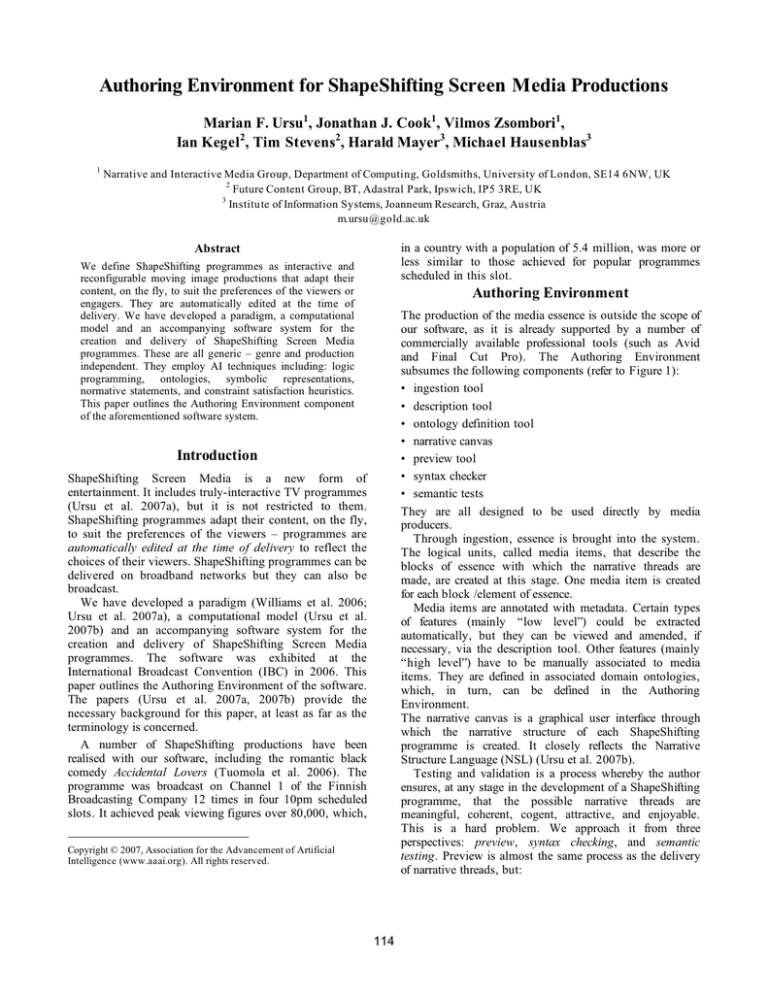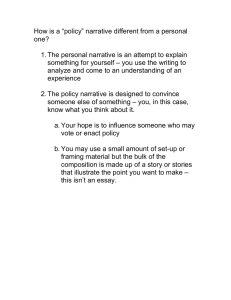
Authoring Environment for ShapeShifting Screen Media Productions
Marian F. Ursu1, Jonathan J. Cook1, Vilmos Zsombori1,
Ian Kegel2, Tim Stevens2, Harald Mayer3, Michael Hausenblas3
1
Narrative and Interactive Media Group, Department of Computing, Goldsmiths, University of London, SE14 6NW, UK
2
Future Content Group, BT, Adastral Park, Ipswich, IP5 3RE, UK
3
Institute of Information Systems, Joanneum Research, Graz, Austria
m.ursu@gold.ac.uk
in a country with a population of 5.4 million, was more or
less similar to those achieved for popular programmes
scheduled in this slot.
Abstract
We define ShapeShifting programmes as interactive and
reconfigurable moving image productions that adapt their
content, on the fly, to suit the preferences of the viewers or
engagers. They are automatically edited at the time of
delivery. We have developed a paradigm, a computational
model and an accompanying software system for the
creation and delivery of ShapeShifting Screen Media
programmes. These are all generic – genre and production
independent. They employ AI techniques including: logic
programming, ontologies, symbolic representations,
normative statements, and constraint satisfaction heuristics.
This paper outlines the Authoring Environment component
of the aforementioned software system. *
Authoring Environment
The production of the media essence is outside the scope of
our software, as it is already supported by a number of
commercially available professional tools (such as Avid
and Final Cut Pro). The Authoring Environment
subsumes the following components (refer to Figure 1):
• ingestion tool
• description tool
• ontology definition tool
• narrative canvas
• preview tool
• syntax checker
• semantic tests
They are all designed to be used directly by media
producers.
Through ingestion, essence is brought into the system.
The logical units, called media items, that describe the
blocks of essence with which the narrative threads are
made, are created at this stage. One media item is created
for each block /element of essence.
Media items are annotated with metadata. Certain types
of features (mainly “low level”) could be extracted
automatically, but they can be viewed and amended, if
necessary, via the description tool. Other features (mainly
“high level”) have to be manually associated to media
items. They are defined in associated domain ontologies,
which, in turn, can be defined in the Authoring
Environment.
The narrative canvas is a graphical user interface through
which the narrative structure of each ShapeShifting
programme is created. It closely reflects the Narrative
Structure Language (NSL) (Ursu et al. 2007b).
Testing and validation is a process whereby the author
ensures, at any stage in the development of a ShapeShifting
programme, that the possible narrative threads are
meaningful, coherent, cogent, attractive, and enjoyable.
This is a hard problem. We approach it from three
perspectives: preview, syntax checking, and semantic
testing. Preview is almost the same process as the delivery
of narrative threads, but:
Introduction
ShapeShifting Screen Media is a new form of
entertainment. It includes truly-interactive TV programmes
(Ursu et al. 2007a), but it is not restricted to them.
ShapeShifting programmes adapt their content, on the fly,
to suit the preferences of the viewers – programmes are
automatically edited at the time of delivery to reflect the
choices of their viewers. ShapeShifting programmes can be
delivered on broadband networks but they can also be
broadcast.
We have developed a paradigm (Williams et al. 2006;
Ursu et al. 2007a), a computational model (Ursu et al.
2007b) and an accompanying software system for the
creation and delivery of ShapeShifting Screen Media
programmes. The software was exhibited at the
International Broadcast Convention (IBC) in 2006. This
paper outlines the Authoring Environment of the software.
The papers (Ursu et al. 2007a, 2007b) provide the
necessary background for this paper, at least as far as the
terminology is concerned.
A number of ShapeShifting productions have been
realised with our software, including the romantic black
comedy Accidental Lovers (Tuomola et al. 2006). The
programme was broadcast on Channel 1 of the Finnish
Broadcasting Company 12 times in four 10pm scheduled
slots. It achieved peak viewing figures over 80,000, which,
Copyright © 2007, Association for the Advancement of Artificial
Intelligence (www.aaai.org). All rights reserved.
114
Figure 1. Authoring Environment for ShapeShifting Screen Media
embedding authoring knowledge and being able to apply it
during authoring time to advise or constrain the author.
• it may be done with essence of lower quality, stills, or
even with text; and
• it may be done for parts of and not necessarily the whole
narrative structure; since a part selected for preview may
depend on other not selected parts, such as via a choice
made there by the engager, all such dependencies must
be resolved before or during the selected part’s preview.
Syntax checking is used simply to ensure that any
narrative object is constructed correctly from the point of
view of NSL.
Semantic tests are dedicated procedures that can extract
characteristics of the narrative space that are meaningful to
authoring. Some are generic and closely linked to the inner
workings of NSL. Examples include: find the conditions
under which a certain point in the narrative space may or
may not be reached; given certain conditions, find the
objects of a selection group that would never be used in
any narrative thread. Others are more specific and
formulated on the basis of heuristics and formalised
expertise regarding authoring. Examples include: does a
selected object comply with the three act structure? Is there
a dominant temporal order in the narratives corresponding
to a narrative object, and if so which is it? Semantic
testing represents our first step towards implementing
intelligence within the authoring environment itself.
Finally, it will be built as a knowledge-based system,
Acknowledgements
th
This work was carried out within the European Union’s 6
Framework Programme Integrated Project “NM2: New
Millennium, New Media” (IST-2003-004124).
References
Tuomola, M.L. (director); Saarinen, L.E (writer); and
Nurminen, M.J. 2006/2007: Accidental Lovers ("Sydän
kierroksella"), Crucible Studio, Helsinki University of Art
and Design Finland. Broadcast on Channel TV1 by YLE, The
Finnish Broadcasting Company.
Ursu, M.F.; Cook, J.J.; Zsombori, V., Zimmer, R.; Kegel, I.;
Williams, D.; Thomas, M.; Wyver, J.; and Mayer, H. 2007a.
Conceiving ShapeShifting TV: A Computational Language for
Truly-Interactive TV. To be published in the Proceedings of
the EuroITV 2007 Conference, Amsterdam.
Ursu, M.F.; Cook, J.J.; Zsombori, V.; Kegel, I.; Williams, D.;
Hausenblas, M.; and Tuomola, M.L. 2007b. ShapeShifting
Screen Media: A Declarative Computational Model for
Interactive Reconfigurable Moving Image Narratives.
Published in this Proceedings (AIIDE 2007).
Williams, D., Ursu, M.F., et.al, 2006. Shape Shifted TV: A Real
Opportunity for Broadband. Proceedings of the International
Broadcast Convention (IBC) 2006, IBC06 Conference
Publication, Amsterdam: 401-409.
115



